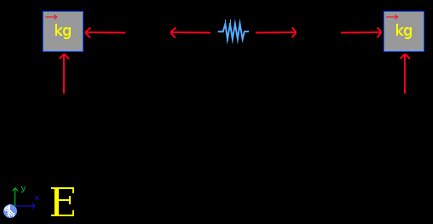Next: Example 6, Previous: Example 4, Up: Examples dynamics of particles [Contents][Index]
11.5 Example 5
A spring with a constant of 1300 N/m, is stretched 8 cm, and is between two blocks as show the image. One block have a mass of 0.5 kg and the other have 0.7 kg. If the spring is released suddenly, and there isn’t friction, Which is the velocity of each block when these leaves the spring?

Solution with FisicaLab
Erase the content of the chalkboard and select the SI system. And add one element Stationary reference system, two elements Block with horizontal movement, one element Spring, and one element Energy. And add the necessary elements Force to make the free body diagram of each block and the spring. As show the image below:

To the element Stationary reference system the time is an unknown data:
- g
9.81
- t
t
To the block at the left, that we assume is the block of 0.5 kg, write:
- Name
A
- m
0.5
- a
a_A
- vi
0
- vf
vf_A
- d
d_A
- Relative to
sf
To the normal force of this block, write:
- f
n_A
To the block at the right, of 0.7 kg, write:
- Name
B
- m
0.7
- a
a_B
- vi
0
- vf
vf_B
- d
d_B
- Relative to
sf
To its normal force:
- f
n_B
To each force applied on the blocks to the spring, write:
- f
f
To each force in the spring, write:
- f
f
The same unknown data that the forces applied to the blocks. Now, to the element Spring:
- Name
Spring
- k
1300
- xi
-8 @ cm
- xf
0
And in the element Energy:
- Object 1
A
- Object 2
B
- Object 3
Spring
- Object 4
0
- W
0
The work is 0, because there isn’t friction. Now click in the icon Solve to get the answer:
t = 0.030 s ; f = 52.000 N ; n_B = 6.867 N ; a_A = -104.000 m/s2 ; vf_A = -3.116 m/s ; d_A = -0.047 m ; a_B = 74.286 m/s2 ; vf_B = 2.225 m/s ; d_B = 0.033 m ; n_A = 4.905 N ; Status = success.
The relevant data are vf_A = -3.116 m/s and vf_B = 2.225 m/s.